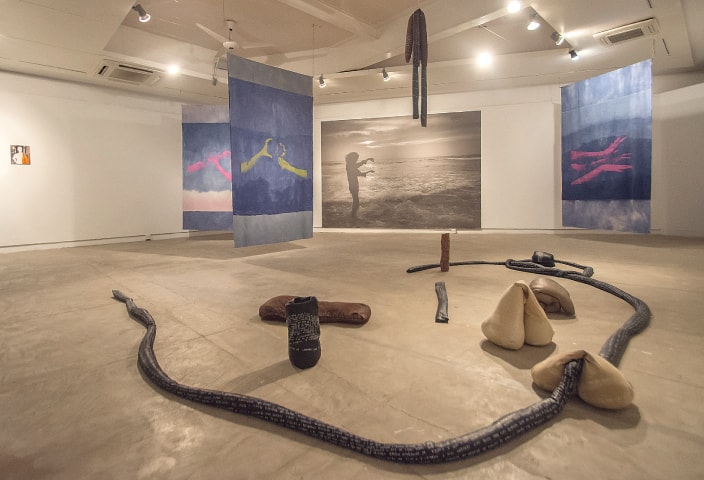
In a recent show at the IVS Gallery, curator Aziz Sohail takes the story of a fictional character as a point of departure to question the limitations and possibilities of language. Anjum is an intersex person in Arundhati Roy’s novel The Ministry of Utmost Happiness. The title of the show “Is it possible to live outside of language?” comes from Anjum’s mother as she struggles to find the vocabulary to define her child within the binary-gendered Urdu language.
The works on display by multidisciplinary local and international artists look at the paradox of language, meant to define, describe and communicate complex ideas yet inevitably binding us with these very definitions. Some of the most interesting works combine spoken, written and visual language in an interplay of installation, sculpture, sound and video.
Vassiliea Stylianidou uses her own speculative fiction, combining text, video, sound and performance to investigate the intersections between a broad spectrum of concerns, including gender identity, sexuality, home, displacement and textile. Her video textually narrates the story of Faraq Shayar Alli-Tis Faraz, who was born an intersex child on the now-sunken island of L-A-Z in the Arabian Sea, grows up in Karachi and is exiled to Greece. Faraq comes up with terms of reference that transcend binary gender such as “Shi” and “Shir.” Now as Shi, Faraq returns to Shir homeland, and has a special garment tailored that transcends gender and will provide anonymity and security. The video’s audio combines selective spoken words from the text with music as the artist performs, navigating this garment on video, struggling with it and attempting to figure it out. The work evokes the idea of language and attire as complicit in creating gender identity and facilitating discriminatory ideals.
A group show questions the limitations of language in the context of gender identity
Lucas Odahara’s work is a combination of sculpture, text, performance, sound and installation. His sculptural pieces are sort of a three-dimensional visual depictions of diverse forms of texts: legal and historical documents, personal stories, poetry, literature and news in different languages.
A rambling text jumping between subject and object and an unending narrative is represented by a long snake-like form spread across the floor. These texts are then performed in sessions and recorded; their interpreted physicality and the difficulty of navigating through them, influencing the way in which they are verbalised.
The display includes sound pieces which are a combination of reading sessions with local Portuguese and Urdu speakers held in Karachi and sessions previously held in Berlin. Together they are meant to investigate the politics of language as it moves across different times and locations.
The work explores how physical bodies and language affect one another, and how their relationship is a kind of a metaphor for the ways in which words can significantly impact mental and physical health in everyday life and in various spheres.
Omer Wasim’s work presents vague imagery, perhaps to make us contemplate the opacity that language forces upon ideas and experiences. Language is absolute, providing concrete terms of reference that submit expansive and complex notions to reductive labels, while these ideas may shift meaning between place and time and from person to person. The work then offers an alternate form of language that is more fluid and open-ended, and open-ended, creating a sort of language that comprises objects as symbols, which can encompass the vastness of the queer experience.
The mirror looks at perception of the self and how each viewer derives a different experience from it. The elusive depiction of the male body covered in a veil both hides and reveals, positioning this new language somewhere in between opacity and fluidity.
“Is it Possible to Live Outside of Language?” is being displayed at IVS Gallery in Karachi from August 22 till September24, 2019
Published in Dawn, EOS, September 15th, 2019















































Dear visitor, the comments section is undergoing an overhaul and will return soon.